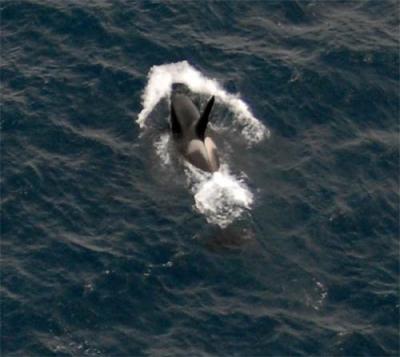The pilot from the helicopter gave us a heads up. Two killer whales headed our way. The announcement resounded through the ship via the pipes (announcement system). For some people on board ship, this was their first glimpse of the orca. Keep on reading if you are interested in learning more about the whale called Killer.
 Killer Whale
Killer Whale
We saw a pod of killer whales all eating heartily. What was on their menu for dinner?
Take a guess. Photo by Dave Withrow
Killer whales are social animals that live in stable family-related groups. Killer whales display a high level of care for their offspring. In addition to the mothers, various pod members (mainly adolescent females) perform most of the care for the calves. As with most mammals, killer whales are very protective of their young.
Different killer whale pods "sound" different. Each pod has their own dialect of sounds. They can easily recognize their own pod from several miles away based on the differences in calls.
Killer whales are often compared to wolves because both species are top predators, maintain complex social relationships, and hunt cooperatively.
To some, killer whales look exactly alike however they can be distinguished from one another by the shape and size of their dorsal fins, the distinctive grayish-white saddle patches behind their dorsal fins, as well as distinctive scars, nicks and marks on their dorsal fins.
What are killer whales like?
Though killer whales, also called orcas, are considered whales by most people, they are actually members of the Delphinidae (dolphin) family. Killer whales are excellent hunters that a wide range of prey, including fish, seals, and big whales such as blue whales. Despite their hunting of other animals, free-ranging killer whales have never been reported killing a human being.
Where do killer whales live?
Killer whales can be found in all oceans but they seem to prefer coastal waters and cooler regions. Killer whales occur in family groups called pods. Three types of pods have been described:
* Resident pods: remain stable over time * Transient pods: dynamic in structure (are constantly changing) * Offshore pods: Are seen only in outer coast waters and not much else is known of them.
"offshore” whales were seen only in outer coast waters.
Killer whale pods are based on the lineage of the mother (mothers, daughters, and sons form groups); the whales live and travel with their mothers even after they are full-grown, forming strongly matriarchal whale societies.
How many killer whales are there?
There are no official killer whale worldwide population estimates. There are minimum counts in local areas. For example, approximately 1000 whales have been individually identified in Alaskan waters through photographs. Killer whales are at the top of the food chain and are not considered endangered.
How can I identify a killer whale?
Killer whales are extremely distinctive with jet-black bodies and white patches usually over the eyes, under the jaw, on the belly, and extending onto their sides. Female killer whales can grow up to 26 feet (7.9 meters) with a 3 foot dorsal fin while males are larger than the females growing up to 28 feet (8.5 meters) with a 6 foot (1.3 meters) dorsal fin. Killer whales have 48 to 52 teeth that are large and conical shaped as well as slightly curved back and inward.
How well do killer whales see or hear?
Killer whales have well-developed, acute senses. They can hear a vast range of sounds and possess skin that is sensitive to touch. Killer whales have excellent vision in and out of water. It is not known whether or not they may have some sort of sense of taste.
What do killer whales eat?
The killer whale diet consists of fish, squid, seals, sea lions, penguins, dolphins, porpoises and large whales like the blue whale. Some killer whales have been known to slide on to beaches in order to capture a good meal. Resident pods (pods that primarily reside in one area) prefer fish whereas transient pods (pods that travel over a relatively wide area) appear to target other marine mammals as prey.
Killer whales are very successful hunters due to their cooperative hunting, where all animals within the pod participate. This coordination is apparently developed and learned within pods.
How do killer whales have their young?
Killer whale males reach breeding age when they are around 22 feet (6.7 meters) long while females can breed when they are about 16 feet (4.9 meters) long. Killer whales breed all year around and calves are born about 8 feet (2.4 meters) long after a 17 month gestation period. Female killer whales usually give birth every 3 to 10 years.
How long do killer whales live? How do they die?
Killer whales have no natural predators (they are the top predators of the oceans) and can live to about 50-80 years old. Killer whales have been hunted by humans but not with enthusiasm as it takes 21 killer whales to produce the same amount of oil as 1 sperm whale.

